The De Bunsen Committee was the first committee established by the British government to determine its policy toward the Ottoman Empire during and following World War I. The committee was established on 8 April 1915 by British Prime Minister H. H. Asquith, and was headed by Maurice de Bunsen. The committee submitted its report on 30 June 1915. [1]
The committee was established in response to a French initiative, to consider the nature of British objectives in Turkey and Asia in the event of a successful conclusion of the war. The committee's report provided the guidelines for negotiations with France, Italy, and Russia regarding the partitioning of the Ottoman Empire. [2]
The members of the committee were as follows: [3]
The impact of Mark Sykes, [4] who later negotiated the Sykes-Picot Agreement, on the committee was said to be "profound". [3] He did not sign the final report having been dispatched on instructions of the War Office at the beginning of June to discuss the Committee's findings with the British authorities in the Near and Middle East and at the same time to study the situation on the spot. He went to Athens, Gallipoli, Sofia, Cairo, Aden, Cairo a second time and then to India coming back to Basra in September and a third time to Cairo in November (where he was appraised of the McMahon–Hussein Correspondence) before returning home on 8 December and finally delivering his report to the War Committee on 16 December.
The De Bunsen committee considered four possible solutions: (1) partition, leaving only a small Ottoman state in Anatolia; (2) preservation subject to Great Power control zones of political and commercial influence; (3) preservation as an independent state in Asia; (4) creation of a decentralised, federal Ottoman state in Asia.
The Committee's report, titled "Committee of Imperial Defence: Asiatic Turkey, Report of a Committee" was issued on 30 June 1915, [5] and recommended the last option as the best solution for meeting the British Empire's defence needs. [6]
Concerning Palestine it reported that it would be “...idle for His Majesty's Government to claim the retention of Palestine in their sphere. Palestine must be recognized as a country whose destiny must be the subject of special negotiations, in which both belligerents and neutrals are alike interested”. In case of the partition or zones of influence options then the Committee defined a British sphere of influence that included Palestine while accepting that there were relevant French and Russian, as well as Islamic interests in Jerusalem and the Holy Places. [7] [8]

The Balfour Declaration was a public statement issued by the British Government in 1917 during the First World War announcing its support for the establishment of a "national home for the Jewish people" in Palestine, then an Ottoman region with a small minority Jewish population. The declaration was contained in a letter dated 2 November 1917 from the United Kingdom's Foreign Secretary Arthur Balfour to Lord Rothschild, a leader of the British Jewish community, for transmission to the Zionist Federation of Great Britain and Ireland. The text of the declaration was published in the press on 9 November 1917.

The San Remo conference was an international meeting of the post-World War I Allied Supreme Council as an outgrowth of the Paris Peace Conference, held at Castle Devachan in Sanremo, Italy, from 19 to 26 April 1920. The San Remo Resolution passed on 25 April 1920 determined the allocation of Class "A" League of Nations mandates for the administration of three then-undefined Ottoman territories in the Middle East: "Palestine", "Syria" and "Mesopotamia". The boundaries of the three territories were "to be determined [at a later date] by the Principal Allied Powers", leaving the status of outlying areas such as Zor and Transjordan unclear.

The Sykes–Picot Agreement was a 1916 secret treaty between the United Kingdom and France, with assent from the Russian Empire and the Kingdom of Italy, to define their mutually agreed spheres of influence and control in an eventual partition of the Ottoman Empire.
The McMahon–Hussein Correspondence is a series of letters that were exchanged during World War I in which the Government of the United Kingdom agreed to recognize Arab independence in a large region after the war in exchange for the Sharif of Mecca launching the Arab Revolt against the Ottoman Empire. The correspondence had a significant influence on Middle Eastern history during and after the war; a dispute over Palestine continued thereafter.
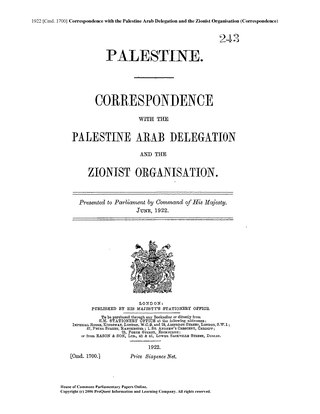
The Churchill White Paper of 3 June 1922 was drafted at the request of Winston Churchill, then Secretary of State for the Colonies, partly in response to the 1921 Jaffa Riots. The official name of the document was Palestine: Correspondence with the Palestine Arab Delegation and the Zionist Organisation. The white paper was made up of nine documents and "Churchill's memorandum" was an enclosure to document number 5. While maintaining Britain's commitment to the Balfour Declaration and its promise of a Jewish national home in Mandatory Palestine, the paper emphasized that the establishment of a national home would not impose a Jewish nationality on the Arab inhabitants of Palestine. To reduce tensions between the Arabs and Jews in Palestine the paper called for a limitation of Jewish immigration to the economic capacity of the country to absorb new arrivals. This limitation was considered a great setback to many in the Zionist movement, though it acknowledged that the Jews should be able to increase their numbers through immigration rather than sufferance.

François Marie Denis Georges-Picot was a French diplomat and lawyer who negotiated the Sykes–Picot Agreement with the British diplomat Sir Mark Sykes between November 1915 and March 1916 before its signing on May 16, 1916.

The King–Crane Commission, officially called the 1919 Inter-Allied Commission on Mandates in Turkey, was a commission of inquiry concerning the disposition of areas within the former Ottoman Empire.

The partition of the Ottoman Empire was a geopolitical event that occurred after World War I and the occupation of Constantinople by British, French, and Italian troops in November 1918. The partitioning was planned in several agreements made by the Allied Powers early in the course of World War I, notably the Sykes–Picot Agreement, after the Ottoman Empire had joined Germany to form the Ottoman–German Alliance. The huge conglomeration of territories and peoples that formerly comprised the Ottoman Empire was divided into several new states. The Ottoman Empire had been the leading Islamic state in geopolitical, cultural and ideological terms. The partitioning of the Ottoman Empire after the war led to the domination of the Middle East by Western powers such as Britain and France, and saw the creation of the modern Arab world and the Republic of Turkey. Resistance to the influence of these powers came from the Turkish National Movement but did not become widespread in the other post-Ottoman states until the period of rapid decolonization after World War II.

The Agreement of St.-Jean-de-Maurienne was an agreement between France, Italy and Great Britain, which emanated from a conference in a railway car at Saint-Jean-de-Maurienne on 19 April 1917 and signed by the allies between 18 August and 26 September 1917.

The Constantinople Agreement was a secret exchange of diplomatic correspondence between members of the Triple Entente from 4 March to 10 April 1915 during World War I. France and Great Britain promised to give Constantinople and the Dardanelles, at the time part of the Ottoman Empire, to the Russian Empire in the event of victory. Britain and France put forward their own claims, to an increased sphere of influence in Persia for Britain, and to the annexation of Syria and Cilicia for France, all sides also agreeing that the governance of the Holy Places and Arabia would be under independent Muslim rule. The Greek government was neutral, but in 1915 it negotiated with the Allies, offering soldiers and especially a geographical launching point for attacks on the Turkish Straits. Greece itself wanted control of Constantinople. Russia vetoed the Greek proposal, because its own main war goal was to control the Straits, and take control of Constantinople.
The Declaration to the Seven was a document written by Sir Mark Sykes, approved by Charles Hardinge, the Permanent Under-Secretary at the Foreign Office and released on June 16, 1918 in response to a memorandum issued anonymously by seven Syrian notables in Cairo that included members of the soon to be formed Syrian Unity Party, established in the wake of the Balfour Declaration and the November 23, 1917 publication by the Bolsheviks of the secret May 1916 Sykes-Picot Agreement between Britain and France. The memorandum requested a "guarantee of the ultimate independence of Arabia". The Declaration stated the British policy that the future government of the regions of the Ottoman Empire occupied by Allies of World War I "should be based upon the principle of the consent of the governed".

The 1921 Cairo Conference, described in the official minutes as Middle East Conference held in Cairo and Jerusalem, March 12 to 30, 1921, was a series of meetings by British officials for examining and discussing Middle Eastern problems, and to frame a common policy. The secret conference of British experts created the blueprint for British control in both Iraq and Transjordan. By offering nominal leadership of those two regions to the sons of the Sharif of the Mecca, Churchill felt that the spirit if not the actual letter of Britain's wartime promises to the Arabs were fulfilled.
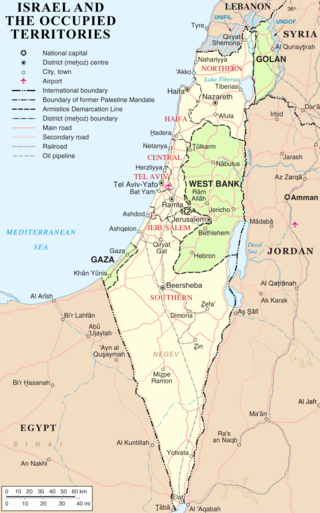
The modern borders of Israel exist as the result both of past wars and of diplomatic agreements between the State of Israel and its neighbours, as well as an effect of the agreements among colonial powers ruling in the region before Israel's creation. Only two of Israel's five total potential land borders are internationally recognized and uncontested, while the other three remain disputed; the majority of its border disputes are rooted in territorial changes that came about as a result of the 1967 Arab–Israeli War, which saw Israel occupy large swathes of territory from its rivals. Israel's two formally recognized and confirmed borders exist with Egypt and Jordan since the 1979 Egypt–Israel peace treaty and the 1994 Israel–Jordan peace treaty, while its borders with Syria, Lebanon and the Palestinian territories remain internationally defined as contested.

Colonel Sir Tatton Benvenuto Mark Sykes, 6th Baronet was an English traveller, Conservative Party politician, and diplomatic advisor, particularly with regard to the Middle East at the time of the First World War.

The Arab Kingdom of Syria was a self-proclaimed, unrecognized constitutional monarchy existing briefly in the territory of historical Syria. It was announced on 5 October 1918 as a fully independent Arab constitutional government with the permission of the British military. It gained de facto independence as an Emirate after the withdrawal of the British forces from OETA East on 26 November 1919, and was proclaimed as a Kingdom on 8 March 1920.
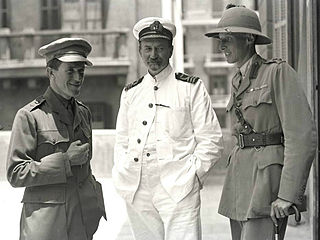
The Hogarth Message was a January 1918 message from Commander David Hogarth, head of the Arab Bureau in Cairo, to Hussein bin Ali, Sharif of Mecca, following Hussein's request for an explanation of the Balfour Declaration.
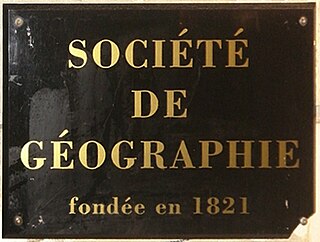
The Arab Congress of 1913 met in a hall of the French Geographical Society at 184 Boulevard Saint-Germain, Paris from June 18–23 in Paris to discuss more autonomy for the Arab people living under the Ottoman Empire. Furthermore The Arab National Congress, which was established by 25 official Arab Nationalists delegates, was convened to discuss desired reforms and to express their discontent with some Ottoman policies. It took place at a time of uncertainty and change in the Ottoman Empire: in the years leading up to World War I, the Empire had undergone a revolution (1908) and a coup (1913) by the Young Turks, and had been defeated in two wars against Italy and the Balkan states. The Arabs were agitating for more rights under the fading empire and early glimmers of Arab nationalism were emerging. A number of dissenting and reform-oriented groups formed in Greater Syria, Palestine, Constantinople, and Egypt. Under Zionist influence, Jewish immigration to Palestine was increasing, and England and France were expressing interest in the region, competing for spheres of influence.
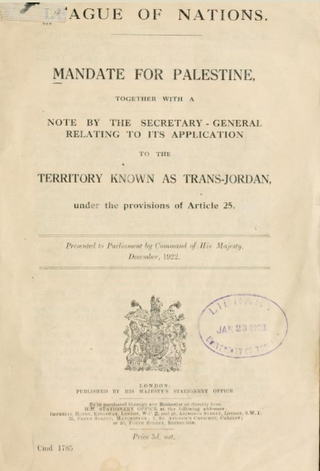
The Mandate for Palestine was a League of Nations mandate for British administration of the territories of Palestine and Transjordan, both of which had been conceded by the Ottoman Empire following the end of World War I in 1918. The mandate was assigned to Britain by the San Remo conference in April 1920, after France's concession in the 1918 Clemenceau–Lloyd George Agreement of the previously-agreed "international administration" of Palestine under the Sykes–Picot Agreement. Transjordan was added to the mandate after the Arab Kingdom in Damascus was toppled by the French in the Franco-Syrian War. Civil administration began in Palestine and Transjordan in July 1920 and April 1921, respectively, and the mandate was in force from 29 September 1923 to 15 May 1948 and to 25 May 1946 respectively.

The London Conference of 1939, or St James's Palace Conference, which took place between 7 February – 17 March 1939, was called by the British Government to plan the future governance of Palestine and an end of the Mandate. It opened on 7 February 1939 in St James's Palace after which the Colonial Secretary, Malcolm MacDonald held a series of separate meetings with the Palestinian and Zionist delegation, because the Palestinian delegation refused to sit in the same room as the Zionist delegation. When MacDonald first announced the proposed conference he made clear that if no agreement was reached the government would impose a solution. The process came to an end after five and a half weeks with the British announcing proposals which were later published as the 1939 White Paper.
The Interregnum period in Transjordan was a short period during which Transjordan had no established ruler or occupying power that lasted from the end of the Franco-Syrian War on 25 July 1920 until the Establishment of the Emirate of Transjordan in April 1921.